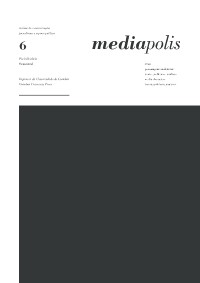Please use this identifier to cite or link to this item:
https://hdl.handle.net/10316.2/93521| Title: | Representações da mulher assassinada no fait divers: uma análise nos jornais The Times, Daily News e Diário Gaúcho | Other Titles: | Representations of women murdered in fait divers: an analysis in the newspaper The Times, Daily News and Diário Gaúcho | Authors: | Moraes, Ana Luiza Coiro | Keywords: | fait divers;feuilleton;characters;journalism genres;fait divers;folhetim;personagens;gêneros jornalísticos | Issue Date: | 2018 | Publisher: | Imprensa da Universidade de Coimbra | Abstract: | O artigo tem como tema o fait divers, investigando através de pesquisa documental as notícias veiculadas nos jornais The Times e Daily News a respeito de mulheres assassinadas
por Jack, o Estripador, no século XIX, e a cobertura do Diário Gaúcho ao caso de uma jovem morta pelo ex-namorado
em 2015. Caracterizando brevemente o gênero jornalístico e o gênero ficcional que surgiram juntos nas páginas dos jornais, e onde Barthes (1971) e Meyer (1996) reconhecem semelhanças, busca-se nos fait divers identificar um específico elemento comum às narrativas do folhetim: a personagem. E, ao investigar o que têm em comum as personagens de ficção e as personagens “reais”, o estudo conclui que estas são um importante fator de aproximação
entre os critérios de seleção e a forma como são veiculados os assuntos que se noticiam e aqueles que compõem a temática das obras ficcionais. The paper focuses on the fait divers, researching through Documentary research the news published in newspapers The Times and Daily News about women murdered by Jack the Ripper in the nineteenth century, and the coverage of the newspaper Diário Gaúcho on the case of young lady killed by ex-boyfriend in 2015. Briefly characterizing the journalistic genre and fictional genre which appeared together in the pages of newspapers, and where Barthes (1971) and Meyer (1996) recognize similarities, we try to identify in fait divers a specific common element to the narratives of the feuilleton: the character. In investigating what the fictional characters and the “real” characters have in common, the study concludes that these are an important factor of similarity between the selection criteria and the way in which the subjects that are reported and those that make up the theme of fictional works. |
URI: | https://hdl.handle.net/10316.2/43609 | ISSN: | 2183-5918 2183-6019 (PDF) |
DOI: | 10.14195/2183-6019_6_6 | Rights: | open access |
| Appears in Collections: | Mediapolis |
Files in This Item:
| File | Description | Size | Format | |
|---|---|---|---|---|
| representacoes_da_mulher_assassinada_no_fait_divers.pdf | 262.94 kB | Adobe PDF |  |
Items in DSpace are protected by copyright, with all rights reserved, unless otherwise indicated.
